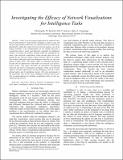Investigating the Efficacy of Network Visualizations for Intelligence Tasks
Author(s)
Berardi, C.; Solovey, E. T.; Cummings, M. L.
DownloadBerardiSoloveyCummings-ISI2013.pdf (825.9Kb)
Metadata
Show full item recordAbstract
There is an increasing requirement for advanced analytical methodologies to help military intelligence analysts cope with the growing amount of data they are saturated with on a daily basis. Specifically, within the context of terror network analysis, one of the largest problems is the transformation of raw tabular data into a visualization that is easily and effectively exploited by intelligence analysts. Currently, the primary method within the intelligence domain is the node-link visualization, which encodes data sets by depicting
the ties between nodes as lines between objects in a plane. This method, although useful, has limitations when the size and complexity of data grows. The matrix offers an alternate perspective because the two dimensions of the matrix are arrayed as an actors x actors matrix. This paper describes an experiment investigating node-link and matrix visualization techniques within social network analysis, and their effectiveness for the intelligence tasks of: 1) identifying leaders and 2) identifying clusters. The sixty participants in
the experiment were all Air Force intelligence analysts and we provide recommendations for building visualization tools for this specialized group of users.
Date issued
2013-06Publisher
Proceedings of IEEE International Conference on Intelligence and Security Informatics (ISI)
Citation
Berardi, C., Solovey, E.T., Cummings, M.L. Investigating the Efficacy of Network Visualizations for Intelligence Tasks, In Proceedings of IEEE International Conference on Intelligence and Security Informatics (ISI), Seattle, WA, June 4-7, 2013.
Keywords
Terrorism, Terrorist Network, Visualization, Node- Link, Matrix, Intelligence Analyst, Social Network Analysis